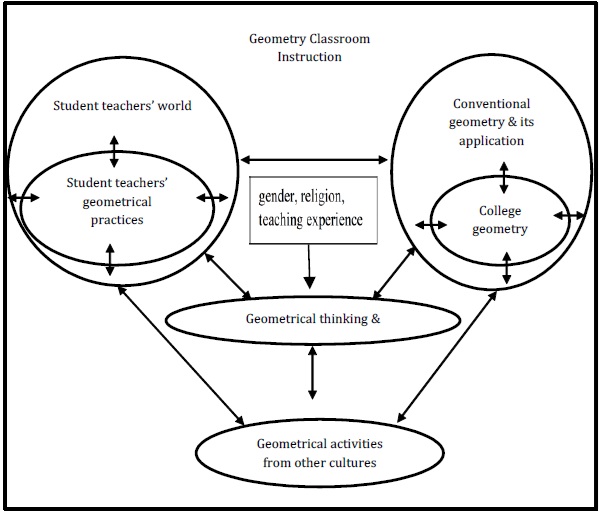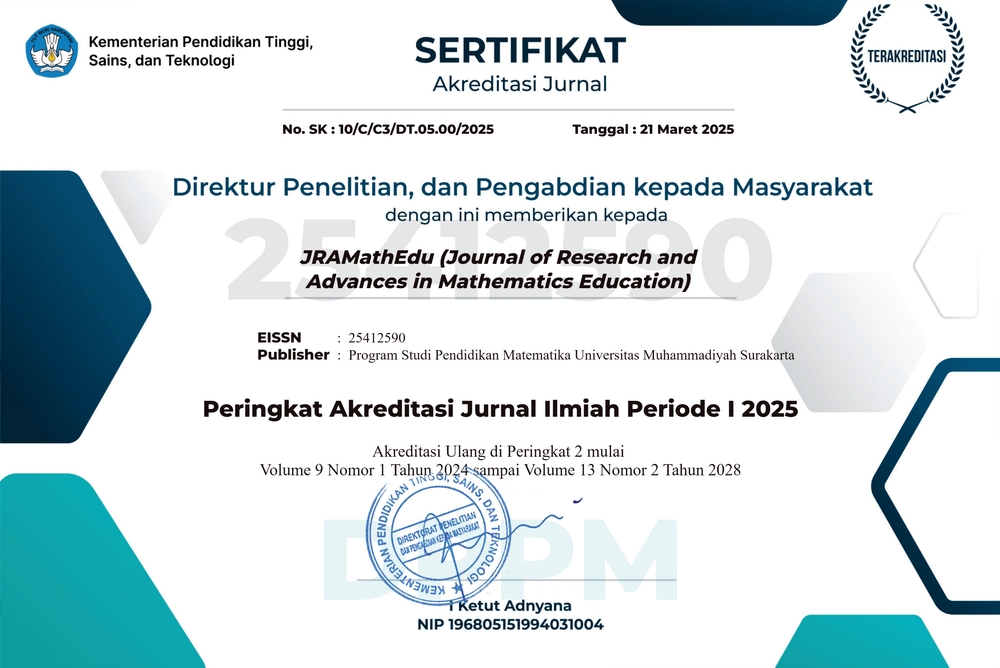Modeling the antecedents of integration of ethnomathematical perspectives into geometry teaching among faculty: A logistic regression analysis
DOI:
https://doi.org/10.23917/jramathedu.v10i1.6374Keywords:
Ethnomathematics, Geometry teaching, Logistic regression model, Teacher educator, Higher educationAbstract
The necessity for establishing links between school mathematics and students' personal lives and cultures, as enshrined in the ethnomathematics program, is being recognized and investigated in different regions across the globe. However, a comprehensive understanding of the antecedents that drive the integration of ethnomathematical perspectives into mathematics teaching among mathematics teachers is still limited. This cross-sectional survey aimed to address this gap by investigating whether the explanatory variables (such as gender, teaching experience, and religion) predict the mathematics teacher educators’ incorporation of the mathematics found outside of school into geometry teaching. We included a sample of 128 mathematics teacher educators in the survey through non-probability sampling. A logistic regression model was employed to analyze the data garnered using a web-based questionnaire. Based on the findings, all three explanatory variables (gender, teaching experience, and religion) did not predict mathematics teacher educators’ incorporation of mathematics found outside of school into geometry teaching. The findings would help key actors of mathematics education to re-examine their beliefs and practices about the incorporation of ethnomathematical perspectives into teaching that builds on students’ socio-cultural experiences. Implications for teaching and future research are reported.
References
Adam, S. (2004). Ethnomathematical ideas in the curriculum. Mathematics Education Research Journal, 16(2), 49-68.
Aikpitanyi, L. A., & Eraikhuemen, L. (2017). Mathematics teachers’ use of ethnomathematics approach in mathematics teaching in Edo state. Journal of Education and Practice, 8(4), 34-38.
Alangui, W. V. (2017). Ethnomathematics and culturally relevant mathematics education in the Philippines. In M. Rosa, L. Shirley, M. E. Gavarrete & W. V. Alangui (Eds.), Ethnomathematics and its Diverse Approaches for Mathematics Education, ICME-13 Monographs (pp. 183-208), Springer International Publishing AG. https://doi.org/10.1007/978-3-319-59220-6_8
Asenahabi, B. M. (2019). Basics of research design: A guide to selecting appropriate research design. International Journal of Contemporary Applied Researches, 6(5), 76-89.
Callegaro, M., Manfreda, K. L., & Vehovar, V. (2015). Web survey methodology. Sage Publications Ltd.
D’Ambrosio, U. (2001). What is ethnomathematics, and how can it help children in schools? Teaching Children Mathematics, 7(6), 308-312.
D’Ambrosio, U. (2016). An overview of the history of ethnomathematics. In M. Rosa, U. D’Ambrosio, D. C. Orey, L. Shirley, W. V. Alangui, P. Palhares & M. E. Gavarrete (Eds.), Current and Future Perspectives of Ethnomathematics as a Programme (pp. 5-10). Springer.
Furuto, L. H. L. (2014). Pacific ethnomathematics: pedagogy and practices in mathematics education. Teaching Mathematics and Its Applications, 1-12. https://doi.org/10.1093/teamat/hru009
Gerdes, P. (2014). Ethnomathematics and education in Africa (2nd ed.). Higher Institute for Technology and Management.
Gill, J., Johnson, P., & Clark, M. (2010). Research methods for managers. SAGE Publications.
Gilsdorf, T. E. (2015). Gender, culture and ethnomathematics. In S. Mukhopadhyay & Breer, B. (Eds.), Proceedings of the Eighth International Conference on Mathematics Education and Society (MES-8), pp. 531-542.
Mathers, N., Fox, N., & Hunn, A. (2009). Surveys and questionnaires. The NIHR RDS for the East Midlands / Yorkshire & the Humber.
Ministry of Education (2017). National teacher education curriculum framework: The essential elements of initial teacher education. Author.
Ministry of Education (2018). Learning and teaching and applying geometry and handling data: A Four-Year B.Ed. Course manual. Author.
Mutodi, P., & Ngirande, H. (2014). Perception of secondary school teachers towards the use of concrete materials in constructing mathematical meaning. Int J Edu Sci, 7(3), 449-461.
Orey, D., & Rosa, M. (2007). Cultural assertions and challenges towards pedagogical action of an ethnomathematics programme. For the Learning of Mathematics, 27(1), 10-16.
Pallant, J. (2016). SPSS survival manual: A step by step guide to data analysis using SPSS (6th ed.). Open University Press.
Pradhan, J. B. (2023). Integrating ethnomathematics approach in teaching school mathematics: inservice teachers’ perception. PROMETEICA-Revista de Filosofiay Ciencias, 27, 400-409. https://doi.org/10.34024/prometeica.2023.27.15321
Putra, E. C. S., & Mahmudah, F. N. (2021). The Implementation of Ethnomathematics Based-Learning for Students. SJME (Supremum Journal of Mathematics Education), 5(2), 162-169. https://doi.org/10.35706/sjme.v5i2.4827
Rosa, M., & Orey, D. C. (2012). The field of research in ethnomodelling: emic, ethic and dialectical approaches. Educ. Pesqui., 38(4), 865-879.
Rosa, M., & Orey, D. C. (2020). Principles of culturally relevant education in an ethnomathematical perspective. Revista de Educação Matemática, 17, 1-24. https://doi.org/10.37001/remat25269062v17id306
Rosa, M., & Orey, D. C. (2021). An ethnomathematical perspective of STEM education in a glocalized world. Bolema, Rio Claro (SP), 35(70), 840-876. http://dx.doi.org/10.1590/1980-4415v35n70a14
Taber, K. S. (2018). The use of Cronbach’s alpha when developing and reporting research instruments in science education. Res Sci Educ, 48, 1273-1296. https://doi.org/10.1007/s11165-016-9602-2
Tayakol, M., & Dennick, R. (2011). Making sense of Cronbach’s Alpha. International Journal of Medical Education, 2, 53-55.
Thakur, S. K. (2019). Integration of ethnomathematics in secondary level: a survey on teachers’ perceptions [Master’s dissertation, Kathmandu University].

Submitted
Accepted
Published
How to Cite
Issue
Section
License
Copyright (c) 2025 Patrick Kyeremeh, Francis Kwadwo Awuah, Daniel Clark Orey

This work is licensed under a Creative Commons Attribution-NonCommercial 4.0 International License.


















